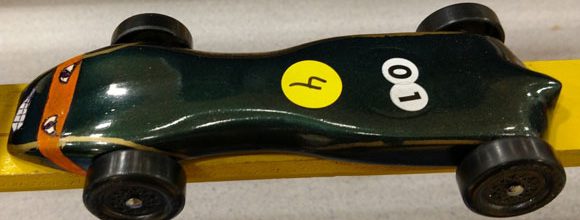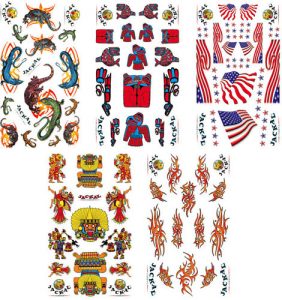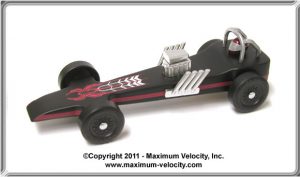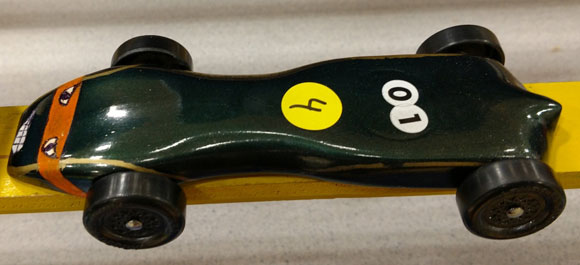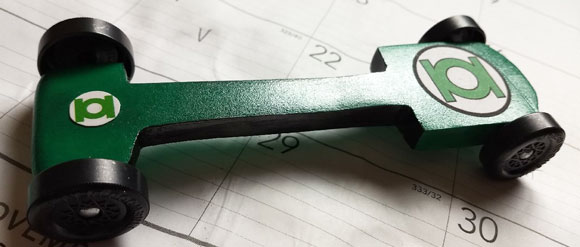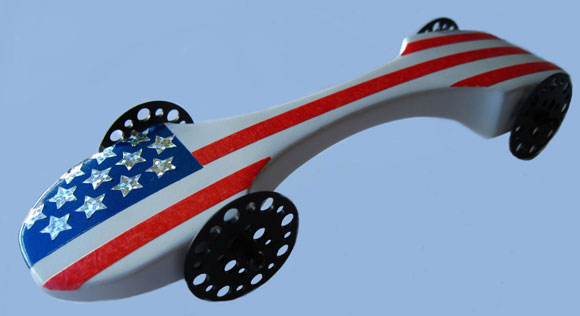In this Edition
– Editor’s Notes
– Feature Article: Points or Times: Which Method Should I Use?
– Humor
– Product Showcase: All Products – 20% Off
– Pinewood Derby Car Showcase
– Pinewood Derby Memory: Crowd Favorite
– Q&A
Editor’s Notes
Bulk Sticker Decal Special Offer
Do you need 25 or more decals to sell or distribute at your group or club? We can offer you a deep discount on bulk sticker decal orders. Contact us for more information.
Inventory Clearance Sale
We are clearing inventory on several pinewood derby items including:
- Tungsten & Tundra Weights
- Awana Speed Wheels
- Funny Car, Vector, and Raptor car kits
- Blocks with Weight Holes
- Tools, including Digital Calipers, 5-ounce test weight, and more.
- DerbyDome
We don’t have many remaining, so don’t delay. You can find these items Here.
Call for Photos
Help, we are out of photos for the Pinewood Derby Car Showcase. Please send us a photo of your car along with a description of any special features to: [email protected]
Please include your full name. If selected, we will include the photo and description in this newsletter.
Photos must be sent by e-mail in JPG format (minimum size of 640×480, maximum size of 1280 x 960). Please shoot photos from the front left of the pinewood derby car, similar to the orientation of this car.
Make sure the photo is not blurry. If your photos are blurry, try holding the camera four or five feet away from the car, and then use the camera’s zoom to fill the frame with the car. Also, use a solid (preferably white) background for the photo. Printer paper works well as a background.
Send only one photo per car, unless an additional photo is needed to adequately show a feature. Don’t forget to include your name, the name of the car (if it has one), and a brief write up on any design features, inspiration for the design, and how the car performed at the race. Thanks.
MV Basic & Wedge Car Kits
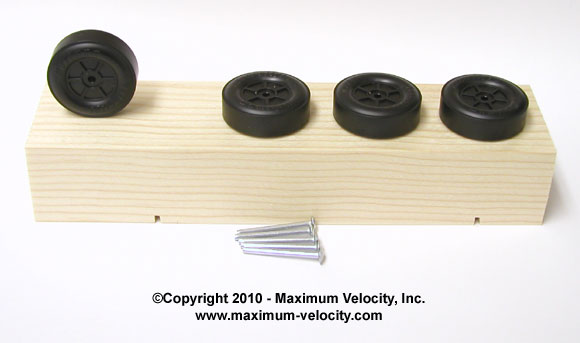
– Quality Block – Unlike the blocks provided by some organizations, our blocks are soft, northwestern pine blocks, cut precisely to 7 inches long, 1-3/4 inches wide, and 1-1/4 inches tall. These dimensions, as well as the axle slots accurately duplicate the dimensions of standard pinewood derby blocks from BSA and PineCar.
– Simple Axle Preparation – Don’t worry about filing off flaws, or losing hub caps. Our Pinewood Derby Speed Axles have no burrs or crimp marks, and install without hub caps. With or without polishing, they are ready to go. We supply five, so you have a spare.
– Quality Wheels – Forget cheap, out of round wheels. Our MV pinewood derby wheels are top-quality wheels. You will not be disappointed with the quality of these wheels.
So, if your organization does not mandate a particular kit type, consider our MV Basic Car Kits or MV Wedge Car Kits. We also offer bulk packs of MV kits in Pre-cut Shapes.
Can We Help?
If we can help you in any way with your pinewood derby project, or if you have any feedback regarding this newsletter, please Contact Us
Feature Article
Points or Times: Which Method Should I Use?
By Randy Davis
(An update of an article first published in Volume 6, Issue 11 of this newsletter).
Life used to be simple. Only a few TV channels to choose from, no Starbucks to give us multiple coffee options, and pinewood derby winners were decided by elimination. But since humans thrive on innovation, we now have lots of channels and coffee choices, and we have other options for running pinewood races.
I, for one, am pleased that other options exist for deciding pinewood derby winners. For years we used a double-elimination method. I tried very hard to make the race fair, but I realized that issues existed. Although reasonably simple to implement, elimination methods are fraught with problems, and – unless very carefully implemented – are not very fair.
So, when I discovered Points racing, our organization quickly shifted over to that method. At the time, we had a finish line judge, but it was not a timer, so there was no debate as to whether to use Points or Times; Points was the only choice.
Then we replaced the finish line judge with a timer and integrated the timer with the Grand Prix Race Manager software. By the magic of software, we could now use Points or Times, and (after the race) dynamically switch back and forth to compare the two methods.
I first did this comparison for our 2004 race. We were using Points and each car ran once in each lane. The top finishers then advanced to a finals round (we advanced 10 cars). In the finals my son’s car ended up taking fourth place. This seemed strange to me, for as I watched the heats, I expected him to take third place.
So, after the race I did a little investigation and discovered that, by average heat time, his car was actually the third-fastest car. How did he end up in fourth place? This happened because of the race mix in the finals.
If each car had raced against every car the same number of times, then the heat mix would not matter. But my son’s car ended up racing against the two fastest cars more than the third-place car. So, he accumulated fewer points than the third-place car, thus taking fourth place.
When I made this discovery, my first thought was, “Next year we are going to use Times!” But later, I decided that making a rash decision wasn’t the wisest move. So, I did some investigation regarding the two methods, the results of which I will now share with you.
Defining Points Versus Times
Just to make sure we are all thinking the same thing, let’s define Points and Times.
The Points method uses a preset race schedule (we use Perfect-N or Partial Perfect-N), (1) wherein each car races the same number of times in each lane, and races against as many other cars as possible. The results of each heat are recorded, with points assigned based on the finish order. Points can be assigned as 4, 3, 2, 1 for 1st, 2nd, 3rd, and 4th places (high points wins), or 1, 2, 3, and 4 points for 1st, 2nd, 3rd, and 4th places (low points wins). The points are then totaled, and the winners decided.
The Times method uses a preset race schedule, wherein each car races the same number of times in each lane. Generally, the cars race against as many other cars as possible, but the heat mix does not affect the outcome. The heat times are accumulated, and then trophies are awarded based on the lowest cumulative time, or lowest average time.
Points: Advantages/Disadvantages
Let’s first look at the advantages and disadvantages of the Points method.
Advantages
– Does not require a timer.
– The eventual winner of the race is not obvious and cannot be decided until the heats are completed (with Times, the audience can oftentimes pick out the fastest car by watching the timer results). This leads to more excitement and anticipation at the race.
– Heat placement is meaningful. A car must place well in the heats to place well overall (with Times, heat placement is largely irrelevant).
– A poor heat only slightly penalizes a car (with Times, a slow heat oftentimes eliminates the car from any chance of winning).
Disadvantages
– More heats are required. With Times, only 1 heat per lane is required to determine the trophy winners. With Points, depending on the number of cars, an additional round will likely be needed to accurately give out the trophies.
– Heat mix affects the results. As described earlier, if scheduled to race against predominantly faster cars, a given car will be penalized.
Times: Advantages/Disadvantages
Now, let’s look at the advantages and disadvantages of the Times method.
Advantages
– Fewer heats are required – only 1 heat per lane.
– Heat mix does not affect the results.
Disadvantages
– Requires a timer – Today, this is not as much an issue as most tracks have timers.
– The final winner can sometimes be determined by the audience by simply watching the timer results. This can cause participants to lose interest.
– The finish order within a given heat (or set of heats) is largely irrelevant. For example, if a car is scheduled to race against slower cars, that car can win every heat, and still not win a trophy. (How do you explain to a child that although their car never lost, they didn’t win?)
– A poor heat significantly penalizes a car. To rectify this, the slowest heat can be eliminated before averaging the heats.
When to Use Points or Times
My opinion is that the Times Method is very appropriate for large events (greater than 50 cars). Using the Times method, the event will go more quickly as each car only needs to run once in each lane. But care must be taken to:
- Ensure that the audience understands that times are being used so heat finish order is not relevant.
- Re-run any heats with a flawed start, or where a car jumps the track.
- Constantly monitor the reported times to make sure they are rational. (2)
For smaller events, I prefer the Point Method. This method produces the best audience engagement as each heat finish order matters. Even though a second round of racing is oftentimes required, a skilled computer operator can create a new round in Grand Prix Race Manager very quickly, and the new round will have few cars, so the additional time is very manageable. For the Points Method, care must be taken to:
- Re-run any heats where a car jumps the track.
- Include the correct number of cars in a finals round. A finals round should always have a Perfect-N chart.(3) This resolves the issue that I found in 2004 when my son placed fourth and should have placed third.
Conclusion
After this analysis, I decided to stick with the Points method for our local race as we generally had less than fifty cars. I believe this method has fewer problems and is more easily understood and accepted by the participants and their parents.
However, as stated above, if your race involves a large number of cars, then the Times method will increase the speed of the event. Large events such as district or regional championship commonly use a Times method for scoring the race. But if you choose to use a Times method, make sure that the method is clearly explained to the participants.
(1) A Perfect-N race chart is one in which every car races the same number of times in each lane, and races against every other car the same number of times. A Partial Perfect-N chart is one in which each car races the same number of times in each lane, and heat assignment is optimized so that no one car races against any other car more or less than one time greater than the average. For more information on this topic, please see: “Runoffs – When and Why to Run Them” in Volume 14, Issue 6.
(2) I have heard of several cases where a timer tripped early resulting in impossibly short times in a heat. This gave the cars in that heat a significant (unfair) advantage, greatly skewing the final results.
(3) For a four-lane track, Perfect-N charts exist for the following numbers of cars: 4, 5, 6(with Bye), 7, 12(with Bye), and 13. For all car counts greater than 13, only PPN charts exist.
Humor
Creation – An Alternate View
On the first day, God created the dog and said, “Sit all day by the door of your house and bark at anyone who comes in or walks past. For this, I will give you a life span of twenty years.”
The dog said, “That’s a long time to be barking. How about only ten years and I’ll give you back the other ten?”
And God saw it was good.
On the second day, God created the monkey and said, “Entertain people, do tricks, and make them laugh. For this, I’ll give you a twenty-year life span.”
The monkey said, “Monkey tricks for twenty years? That’s a pretty long time to perform. How about I give you back ten like the dog did?”
And God, again, saw it was good.
On the third day, God created the cow and said, “You must go into the field with the farmer all day long and suffer under the sun, have calves and give milk to support the farmer’s family. For this, I will give you a life span of sixty years.”
The cow said, “That’s kind of a tough life you want me to live for sixty years. How about twenty and I’ll give back the other forty?”
And God agreed it was good.
On the fourth day, God created humans and said, “Eat, sleep, play, marry and enjoy your life. For this, I’ll give you twenty years.”
But the human said, “Only twenty years? Could you possibly give me my twenty, the forty the cow gave back, the ten the monkey gave back, and the ten the dog gave back; that makes eighty, okay?”
“Okay,” said God, “You asked for it.”
So that is why for our first twenty years, we eat, sleep, play and enjoy ourselves.
For the next forty years, we slave in the sun to support our family.
For the next ten years, we do monkey tricks to entertain the grandchildren.
And for the last ten years, we sit on the front porch and bark at everyone.
Life has now been explained to you. There is no need to thank me for this valuable information. I’m doing it as a public service. If you are looking for me, I will be on the front porch.
Product Showcase
All Products – 20% Off
Through March 19, 2019, you can get 20% Off your entire order. To take advantage of this limited time offer use coupon code Mar06NL during checkout.
Pinewood Derby Car Showcase
Tortoise Flier – Connor St John
This car features highly polished axles and hand lathed wheels and took 1st in the pack and 2nd in districts.
Low Rider – Rob Dauphinais
I wanted to let you know about another great result we got after using your web site and products. This past weekend we drove up to Nashua, New Hampshire to participate in their local cub pack Adult Pinewood Derby fund raiser. I had built a car using your Low Rider plans (after winning our work race last year with the Wedge Plans). The Low Rider was very fast, and we were lucky enough to win (with last year’s car as second place to boot)
Raptor – Doug Thorne
I won first place in the Outlaw Class using your Raptor Kit and X-Lite Needle Axle Outlaw Wheels. Thanks again for providing great products, good advice, and fast service.
Share Your Car Photo
Do you have a car you would like to “show off” to our readers? If so, send us a photo of your car along with a description of any special features to: [email protected]
Please include your full name. If selected, we will include the photo and description in this newsletter.
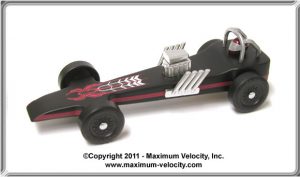
For better focus, keep the camera four or five feet away from the car, and then use the camera’s zoom to fill the frame with the car. Also, use a solid (preferably white) background for the photo.
Send only one photo per car, unless an additional photo is needed to adequately show a feature. Also, only one car per subscriber per year please. Thanks.
Pinewood Derby Memory
Crowd Favorite
Last year my son was a Bear and it was our third year competing in the pinewood derby. After talking with him, he decided he wanted to build a really fast car but wanted to have “Sponge Bob” involved in it somehow. The previous years he had done okay winning his Tiger level and placing third in his Wolf level.
So, we ordered some of your speed supplies and we went to work. We kept the car design simple, just a slightly modified wedge. We pirated some parts from one of those mini remote-control cars you can get at Radio Shack and added them to the car.
The best part was when the racing started all of the Scouts (this is no exaggeration) began chanting: “Sponge Bob – Sponge Bob – Sponge Bob” every time his car raced. To watch his eyes when this happened was magical. My son is a little shy and to have everyone cheering for him was a real surprise to him.
He raced 9 different times last year and never lost a race. There was only one car faster, but it was disqualified (the wheel base was extended, and the wheels were shaped) so he won the overall and the Bear level.
I really would not have cared if he came in last because he was the center of attention for a short period. He really didn’t care how the car did either; he was just tickled to be that popular.
This is what scouting and pinewood derby is all about – working together to build a car and create a great memory.
David Brymer
Do you Remember?
If you have a pinewood derby story that is funny, unusual, sad, heart-warming, etc., please send it to me in an e-mail. Don’t worry about literary polish. We will edit as needed before publishing.
If your story is used, you will receive a $10 coupon in May of 2019.
Q&A
I am trying to figure out the best way to lubricate the wheels when also doing the rail riding alignment (I haven’t done this before). I have read about wheel bore packing and trying to get a good amount of graphite in the wheels. Last year was our first year doing this and I definitely think the car slowed down compared to the rest of cars. So, I would like to pack graphite after the axles are aligned for rail riding, but it’s hard to do that without removing the axles. What do you suggest?
I would avoid removing the axles after you have them set properly. Instead, thoroughly lubricate the wheels/axles before mounting them on the car. Spend at least 5 minutes per wheel/axle adding graphite, spinning, adding, spinning, etc. Always end by spinning several times. Then mount and align.
Rail-rider alignment is not done on the track – it is done on a test board. So, you don’t really use up the graphite. If you have access to a track, you can certainly do a few runs, but no more than 5. Then glue the axles in place and put the car away until the race.
The term graphite “packing” can mean a lot of things. YouTubers would have you jam the graphite in, but that causes more problems than it solves. It is best to put down graphite in layers by adding and spinning. This makes sure the wheel bore is evenly coated with graphite.
I have the Pro-Axle Bender and I’m planning on purchasing the Pro-Grooved Stainless Axles (Viper). How much of a bend would you recommend for the front and rear axles?
I like to use 1.5 in the front and 2.5 in the rear. This gives the benefit of rail-riding and allows for relatively easy steering adjustment during the alignment process. However, some people do use larger angles, especially on the front steering wheel. A larger angle minimizes the contact patch between the wheel and guide rail, but it does make the car trickier to align.
Is there a weight that is too much for an outlaw car? A scout group is having an outlaw race with no rules, I just want to run a gravity powered car but wonder if one can get too heavy. Thank you
The answer depends on the length of the track and the lubrication type. I did an experiment with Krytox 100 and performance peaked out at 14 ounces on a 32-foot track. See Pinewood Derby Times, Volume 16, Issue 2 for more information.
In another experiment using graphite, performance peaked at 9 to 10 ounces.
Just be aware that as you increase the weight of the car, the stopping distance increases, and the force required to stop the car increases. If the braking section is short, the car will plow into whatever barrier is present at the end of the braking section. If the car is fragile, it could be damaged. So, make sure the car body is robust; and if you have an extended wheelbase inset the front wheels so that they don’t make hard contact with the barrier.
Want Answers?
Do you have a pinewood derby-related question? If so, e-mail us your question.We answer all questions by e-mail, but not every question will appear in the Q&A section of the newsletter.
Back Issues
Are you a new subscriber, or have you missed some of the previous newsletters? Don’t miss out; all of the issues for Volume 5 through Volume 18 are posted on our web site.
Newsletter Contributions
We welcome your contributions. If you would like to contribute an article, a web site review, a speed tip, or a pinewood derby memory, please e-mail us.
Subscription Information
The Pinewood Derby Times is a free e-newsletter focused on pinewood derby racing. It is published biweekly from October through March.
If you haven’t already done so, please forward this issue to your pinewood derby friends. But please don’t subscribe your friends. Let them decide for themselves. Thanks.
If this newsletter was forwarded to you, why not subscribe to receive this newsletter. There is no cost, and your e-mail address is safe, as we never sell or share our distribution list.
To subscribe, send a blank e-mail to
[email protected]
You will receive a confirmation e-mail. Reply to the confirmation e-mail and you will start receiving the Pinewood Derby Times with the next issue.
Randy Davis, Editor, Pinewood Derby Times
E-Mail: [email protected]
(C)2019, Maximum Velocity, Inc. All rights reserved. Please do not reprint or place this newsletter on your web site without explicit permission. However, if you like this newsletter we grant permission, and encourage you to e-mail it to a friend.
Maximum Velocity disclaims any personal loss or liability caused by utilization of any information presented in this newsletter.
The Pinewood Derby Times is not specific to, and is not affiliated with the Boy Scouts of America, YMCA, Awana, or any other organization.
(R)Maximum Velocity is a registered trademark of Maximum Velocity, Inc.
(R)Pinewood Derby is a registered trademarks of the Boys Scouts of America.
(R)Awana is a registered trademark of Awana Clubs International.
All other names are trademarks of their respective owners.

